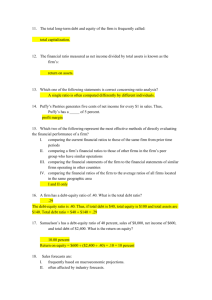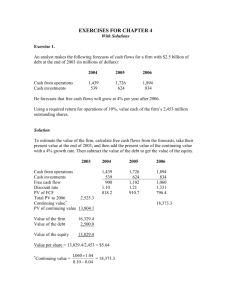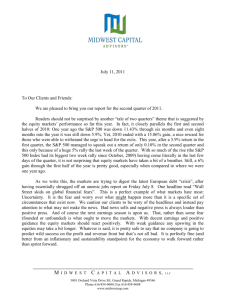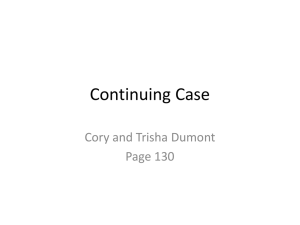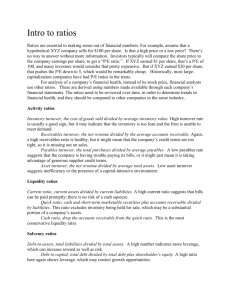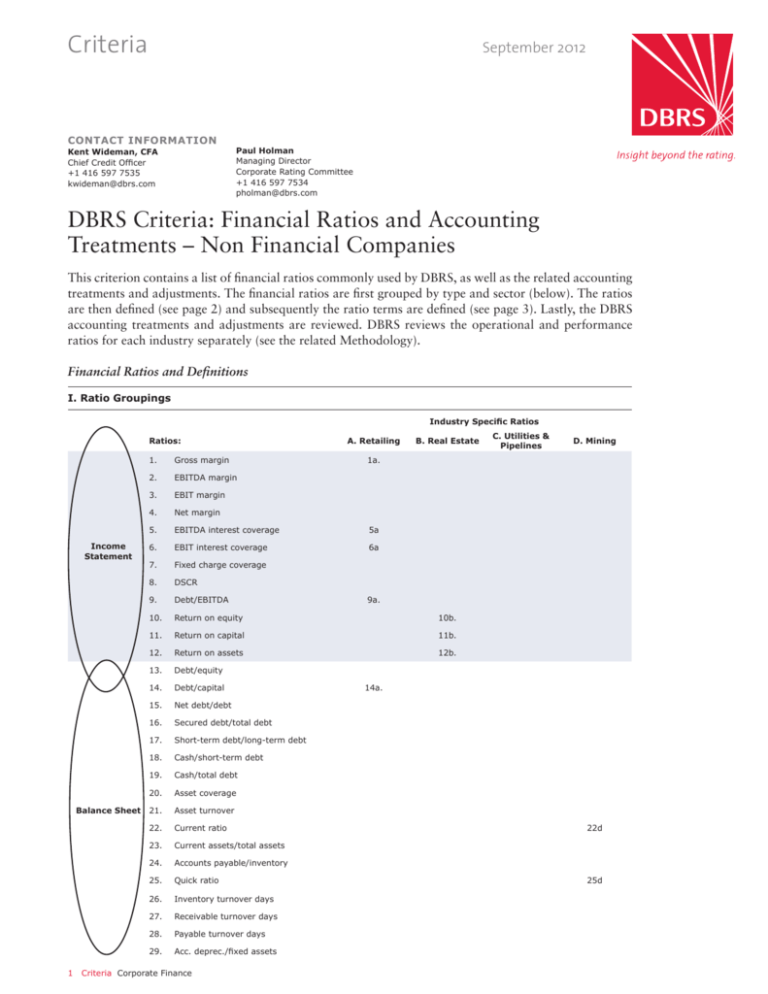
Criteria
September 2012
CONTACT INFORMATION
Kent Wideman, CFA
Chief Credit Officer
+1 416 597 7535
kwideman@dbrs.com
Paul Holman
Managing Director
Corporate Rating Committee
+1 416 597 7534
pholman@dbrs.com
DBRS Criteria: Financial Ratios and Accounting
Treatments – Non Financial Companies
This criterion contains a list of financial ratios commonly used by DBRS, as well as the related accounting
treatments and adjustments. The financial ratios are first grouped by type and sector (below). The ratios
are then defined (see page 2) and subsequently the ratio terms are defined (see page 3). Lastly, the DBRS
accounting treatments and adjustments are reviewed. DBRS reviews the operational and performance
ratios for each industry separately (see the related Methodology).
Financial Ratios and Definitions
I. Ratio Groupings
Industry Specific Ratios
Ratios:
Income
Statement
Balance Sheet
1
A. Retailing
1.
Gross margin
2.
EBITDA margin
3.
EBIT margin
4.
Net margin
5.
EBITDA interest coverage
5a
6.
EBIT interest coverage
6a
7.
Fixed charge coverage
8.
DSCR
B. Real Estate
D. Mining
1a.
9.
Debt/EBITDA
10.
Return on equity
10b.
11.
Return on capital
11b.
12.
Return on assets
12b.
13.
Debt/equity
14.
Debt/capital
15.
Net debt/debt
16.
Secured debt/total debt
17.
Short-term debt/long-term debt
18.
Cash/short-term debt
19.
Cash/total debt
20.
Asset coverage
21.
Asset turnover
22.
Current ratio
23.
Current assets/total assets
24.
Accounts payable/inventory
25.
Quick ratio
26.
Inventory turnover days
27.
Receivable turnover days
28.
Payable turnover days
29.
Acc. deprec./fixed assets
Criteria Corporate Finance
C. Utilities &
Pipelines
9a.
14a.
22d
25d
Criteria
September 2012
I. Ratio Groupings
Industry Specific Ratios
Ratios:
30.
Cash Flow
Statement
A. Retailing
B. Real Estate
C. Utilities &
Pipelines
D. Mining
Cash flow/interest
31.
Cash flow/debt
32.
Cash flow/capex
33.
Cash flow - dividends/capex
34.
Depreciation/capex
35.
Capex/revenue
36.
Cash/capex
37.
Common dividend payout ratio
38.
Total dividend payout ratio
39.
Common dividend/cash flow
40.
Distribution payout ratio
31a.
31c
34d
II. Ratio Definitions1, 2
1.
Gross margin = Gross profit/revenue
2.
EBITDA margin = EBITDA/revenue
3.
EBIT margin = EBIT/revenue
4.
Net margin = Core net income before minority interest/revenue
5.
EBITDA interest coverage = EBITDA/gross interest expense
5a
EBITDAR interest coverage = EBITDAR/gross interest expense + operating lease interest expense
6.
EBIT interest coverage = EBIT/gross interest expense
6a
EBITR interest coverage = EBIT + operating lease interest expense / (gross interest expense + operating lease
interest expense)
7.
Fixed charge coverage = EBIT + operating leases / (gross interest expense + operating leases + preferred
dividends (tax adjusted))
8.
DSCR = (Revenue - cash operating expense - income tax - maintenance capex)/(interest expense + principal
amortization)
9.
Debt/EBITDA = Total debt/EBITDA
9a
Adjusted debt/EBITDAR = Total adjusted debt/EBITDAR
10.
Return on equity = Core net income after minority interest/average common equity
10b
Return on equity = Cash flow from operations/average shareholder’s equity
11.
Return on capital = EBIT * (1 - tax rate)/average total capital
11b
Return on capital = Cash flow from operations/average total capital
12.
Return on assets = EBIT * (1 - tax rate)/average total assets
12b
Return on assets = Cash flow from operations/average total assets
13.
Debt/equity = Total debt/total equity
14.
Debt/capital = Total debt/total capital
14a
Adjusted debt/capital = Total adjusted debt/total adjusted capital
15.
Net debt/capital = (Total debt - cash)/(total capital - cash)
16.
Secured debt/total debt = Secured debt/total debt
17.
Short-term debt/long-term debt = Short-term debt/long-term debt
2
Criteria Corporate Finance
Criteria
September 2012
II. Ratio Definitions1, 2
18.
Cash/short-term debt = Cash/short-term debt
19.
Cash/total debt = Cash/total debt
20.
Asset coverage = (Total assets - goodwill - future tax liability - deferred credits - minority interest - current
liabilities + current portion of long-term debt + short-term debt)/total debt.
21.
Asset turnover = Total revenue/average total assets
22.
Current ratio = Current assets/current liabilities
22d
Current ratio, adjusted = Non-monetary current assets/non-monetary current liabilities
23.
Current assets/total assets = Current assets/total assets
24.
Accounts payable/inventory = Accounts payable/inventory
25.
Quick ratio = (Cash + receivables)/(total current liabilities)
25d
Quick ratio, adjusted = (Cash + receivables + inventory)/(short-term debt)
26.
Inventory turnover days = 365 * (average inventories/cost of goods sold)
27.
Receivable turnover days = 365 * (average account receivables/revenues excluding)
28.
Payable turnover days = 365 * (average accounts payable/cost of goods sold)
29.
Acc. deprec./fixed assets = Accumulated depreciation/gross fixed assets
30.
Cash flow/interest = (Cash flow from operations + after-tax interest expense)/after-tax interest expense
31.
Cash flow/debt = Cash flow from operations/total debt
31a
Adjusted cash flow/total debt = Cash flow from operations + after-tax operating lease interest expense/(total
debt + capitalized operating leases)
31c
Debt/cash flow = Total debt/cash flow from operations
32.
Cash flow/capex = Cash flow from operations/capex
33.
Cash flow - dividends/capex = Cash flow from operations - preferred dividends - common dividends/capex
34.
Depreciation/capex = Depreciation/reported capex
34d
Capex/depreciation, adjusted = Reported capex/(depreciation + amortization +depletion)
35.
Capex/revenue = Capex/revenue
36.
Cash/capex = Cash/capex
37.
Common dividend payout ratio = Common dividends/core net income, less preferred dividends and minority
interest
38.
Total dividend payout ratio= Common and preferred dividends/core net income, less minority interest
39.
Common dividend/cash flow = Common dividends/cash flow from operations
40.
Distribution payout ratio = Distribution/cash flow available for distribution
1. Any ratios deviations from those noted above should have an explanatory footnoted in the report.
III. Ratio Term Definitions1,2
1.
Amortization = Reported amortization of goodwill & intangible assets
2.
Assets, total = Reported current and long-term assets
3.
Assets, tangible = Total assets - goodwill - intangible assets
4.
Capex = Reported capital expenditures
5.
Capital, total = Total debt + total preferred equity + total common equity + minority interest+ capital leases
6.
Capital leases = All non-operating leases that are capitalized on the balance sheet and depreciated
7.
Capital, adjusted = Total capital + capitalized operating leases
8.
Cash = Cash & cash equivalents + short-term investments
3
Criteria Corporate Finance
Criteria
September 2012
III. Ratio Term Definitions1,2
9.
Cash flow from operations = Core net income + depreciation + amortization + deferred taxes + other non-cash
items from income statement (before capex and changes in non-cash working capital)
10.
Cash flow available for distribution = Cash flow from operations - maintenance capex - leasing costs (before
working capital)
11.
Cash flow, free = Cash flow from operations - capex - dividends - change in non-cash working capital
12.
Cash flow, free, before change in w/c = Cash flow from operations - capex - dividends
13.
Cost of goods sold = Costs incurred in production before depreciation
14.
Current assets = Cash & cash equivalents + short-term investments + receivables + inventories + current
deferred tax +prepaid expenses + other current assets
15.
Current liabilities = Accounts payable + accrued expenses+ current income taxes payable + notes/short-term
debt + current portion of long-term debt & capital lease obligations + current deferred tax liability + other
current liabilities
16.
Debt, total = Short-term debt + long-term debt + hybrid debt portion + capital leases (3)
17.
Debt, net = Total debt - cash
18.
Debt, short-term = Notes/short-term debt + current portion of long-term debt
19.
Debt, long-term = Total debt - short-term debt
20.
Debt, adjusted = Total debt + capitalized operating leases
21.
Debt, hybrid = Debt securities with equity-like features
22.
Depreciation = Reported depreciation
23.
Depletion = Reported amortization of value of resource property
24.
Dividends, common = Reported common dividends
25.
Dividends, total = Common dividends + preferred dividends + special dividends
26.
Distribution = Amounts paid out to unit holders (usually from income trusts and REITs)
27.
EBITDA = Revenue - cost of good sold - SG&A (footnote ratio if pension expense removed)
28.
EBITDAR = EBITDA + operating lease expense
29.
EBITDA, cash = EBITDA excluding non-cash items
30.
EBIT = EBITDA - depreciation - amortization (before removing minority interest in earnings)
31.
Equity, common = Common shares + retained earrings + additional paid in capital
32.
Equity, total = Common equity + preferred equity + hybrid equity portion
33.
Gross profit = Revenue - cost of goods sold
34.
Hybrids = Debt hybrids + other securities with equity-like features
35.
Interest expense, gross = All interest expense + debt hybrid interest expense + capitalized interest (exclude any
IFRS adjustments)
36.
Interest expense, net = Gross interest expense - interest income from cash and short-term investments
37.
Interest income = Interest and investment income
38.
Inventory = Reported inventory including materials and finished product
39.
Lease adjusted debt = Total debt + capitalized operating leases
40.
Leasing costs = Tenant inducements, etc.
41.
Minority interest = Ownership by others of consolidated subsidiaries (including common shares and preferred
shares)
42.
Minority interest in earnings = Minority interest in earnings of consolidated subsidiaries, joint ventures and
partnerships
43.
Net income, core = Reported net income, adjusted to remove the impact of unusual items
44.
Net income, reported = Reported net income
45.
Operating lease interest expense = Operating lease ÷ 3
46.
Operating lease expense (rent) = Next period operating lease expense
4
Criteria Corporate Finance
Criteria
September 2012
III. Ratio Term Definitions1,2
47.
Operating lease, capitalized = Operating leases* 6
48.
Payables = Reported other payables
49.
Receivables = Reported receivables + notes receivable
50.
Revenue (and sales, interchangeable) = Reported revenue of owned operations
51.
Revenue, system = Revenue + franchisee and affiliate revenue
52.
SG&A = All other costs besides cost of goods sold
53.
Tax, cash = Actual cash remitted
54.
Tax, deferred = Reported deferred income taxes, may be adjusted to remove the impact of unusual items
55.
Tax, income = Cash and deferred income tax, adjusted to remove the impact of unusual items
56.
Tax, reported = Reported income tax, before removing the impact of unusual items
57.
Unusual items = Merger & restructuring charges + impairment of goodwill + gain (loss) on sale of assets &
investments + asset write-down + insurance & legal settlements
58.
Working capital = Current assets - current liabilities
(1) All numbers are to be annualized and normalized where applicable.
(2) All ratios include the assets and income of any minority interests. Minority interests are included in total capital. When minority
interests are removed from total capital and net income the numbers and ratios must be properly annotated.
(3) Debt can also include off-balance sheet financing. Ratios including this debt number would be separate and annotated.
Accounting Treatments and Adjustments
These are some of the more common issues that arise with financial statements and related areas where
DBRS will consider adjustments. The adjustments are intended to provide greater analytical transparency rather than recast the financial statements. The adjustments can be universal (see below) or relate to
specific industries (see the respective DBRS Methodology). In many cases, DBRS will make adjustments
only when the impact is considered material and some adjustments will be isolated to certain key ratios.
Footnotes should be added where necessary to facilitate transparency.
Note asset values reported under GAAP are normally based on book values. Asset values reported under
IFRS may be based on book or market values. Where companies elect to use market values, DBRS may,
during the first year or two, estimate the book values that would have been under GAAP. In this way,
select ratios can be shown both ways for a period of time (i.e., using market values and book values).
During this period, the trend line for the new ratios would become established.
(Note: When a company issues restated financial statements, DBRS will use them for the last two fiscal
years and any current stub periods. The years prior will remain as shown in the annual report for that
year.)
Income Statement
1. Revenue
In most cases, companies report gross revenue. In some cases, companies provide net revenue after certain
expenses. In almost all cases, DBRS will use gross revenue, unless net revenue conforms to industry
practice.
In some cases, companies sell to their franchisee, dealer and/or affiliate networks. In these cases, companies often provide system revenues that provide total network sales to end customers. Provided they are
clearly marked, DBRS can include system revenues and related ratios along with reported revenue.
2. Operating Earnings
In most cases, operating earnings (gross income, EBITDA, EBIT, etc.) are prior to the deduction of interest
expense and income taxes. Gross income is revenue less cost of goods sold. EBITDA is revenue less cost of
goods sold and SG&A. EBIT is EBITDA less depreciation and amortization. Earnings should not include
unusual items and miscellaneous items.
5
Criteria Corporate Finance
Criteria
September 2012
3. Interest Expense (Gross)
DBRS includes only cash interest attributed to indebtedness in interest expense. This includes capitalized
interest. Any other expense/income items (often under IFRS) are removed. DBRS adds the cost associated
with a hybrid security to fixed charge coverage ratios.
4. Fixed Charge Expense
DBRS adds additional items to interest expense to drive the fixed charge expense. This includes preferred
share dividends (tax adjusted, i.e., divide by 1 - tax rate).
5. Capitalized Development Costs
DBRS does not normally adjust reported financial statements by shifting capitalized amounts to expense.
This makes it difficult to compare similar companies that provide different accounting treatments. In
cases where capitalized development costs are material, the higher earnings should be annotated so that
they are seen in proper context.
6. Unusual Items
A wide variety of metrics can be distorted by items that may not meet the accounting definition of
“extraordinary,” but are nevertheless one time and considered unrepeatable. Unless these unusual items
are identified and removed, with proper tax adjustments, earnings and cash flow metrics and related
ratios cannot be considered as “core.” Having noted this, care must be taken in any of the following
adjustments:
(a) There are cases where it would be incorrect to remove items in isolation (there may be corresponding related expenses or revenues).
(b) There are cases where certain costs may be ongoing and the “one time” conclusion must be challenged (year-after-year reorganization costs is one example).
(c) Unusual should not be confused with volatility. An entity may have a very unstable revenue source
but it is still part of its ongoing operations and should not be removed from core earnings simply
because it is volatile.
(d) Companies can default due to one-time costs. It may be reasonable to remove an entity’s major
litigation settlement or reorganization costs to get a more accurate picture of core results, but one
should not forget that whether it is a one-time cost or otherwise, these expenses are still a cost that
could cause a variety of challenges. The latter may include covenant triggers.
7. Pre-Tax Income
As noted above, DBRS may normalize pre-tax income by removing extraordinary, usual and any other
one-time items that will not reoccur in the future.
8. Income Taxes
Where possible, DBRS may adjust accounting income taxes to remove the impact of one-time items, etc.
9. Net Income
Core net income is derived using the normalized pre-tax income and normalized income tax as noted
above (versus reported net income). Core net income is intended to approximate the net income that
would have been the case if there had been no one-time items. (See the cash flow topics below.)
Cash Flow Statement Adjustments
1. Cash Flow from Operations
Cash flow from operations starts with core net income (see above), adds back normalized deferred taxes
(if a reasonable estimate can be made). As well, the other non-cash items that normally flow-through the
income statement are reversed (i.e., depreciation). This yields a normalized cash flow from operations,
which is intended to approximate what cash flow would have been if there had been no one-time items.
6
Criteria Corporate Finance
Criteria
September 2012
This allows the cash flow-to-debt ratios to be comparable over time. (Cash flow from operations is before
capex and changes in working capital.)
2. Free Cash Flow
Free cash flow is defined as cash flow from operation less (a) capex, (b) dividends and (c) change in
non-cash working capital. It should also be net of payments on pension deficits and any residual cash
credits/debits that were excluded when deriving normalized cash flow from operations. In this way, the
final change in cash will reconcile with the change in cash noted in the company’s statement. Free cash
flow is the amount that precedes investing and financing activities.
Balance Sheet Adjustments
Balance sheet ratios based on financial statements (1) using book values or market values or (2) having
large amount of goodwill due to acquisitions can be materially different. Cash flow statements are typically not affected by these accounting factors to the same degree, and thus cash flow ratios are usually
more meaningful than balance sheet ratios, such as the percentage of debt in the capital structure (although
the latter is still considered a useful metric). Where there are meaningful differences, the reasons should be
noted. In this process, the following points should be considered:
1. Asset Valuation (General)
(a) When two or more companies in the same industry elect different approaches under IFRS so that
similar assets have materially different values (i.e., book versus market), the values and ratios are
not adjusted. However, where the differences are noteworthy, the analysis should address this and
the credit implications, if any.
(b) Companies making acquisitions or investing in brands can result in large amounts goodwill and
intangible assets. Similarly, long-term assets in general may be overvalued or undervalued simply
through obsolescence, depreciation/amortization over too long a time period or overestimates of
residual values. In these cases, the equity base can be inflated, yielding more favourable debt-toequity and debt-to-capital ratios. Conversely, the company could show a lower return on equity.
This will need to be taken into account where there are credit implications.
2. Surplus Cash and Marketable Securities
DBRS normally focuses on gross debt ratios, although net debt ratios are often provided. The reason is
that it is not easy to establish that the liquid securities in fact would be used to reduce debt in the future.
One must understand the company’s working capital needs, the nature of its short-term funding requirements, whether the use of the funds is restricted by where they sit in the company’s structure (different
country or regulators could be issues) and future plans regarding capital expenditures, expansions and
acquisitions. DBRS tends to treat these situations on a case-by-case basis and would require a high degree
of comfort before focusing on net debt ratios.
3. Receivable and Inventory Valuation
Receivable and inventory valuations are not adjusted to reflect LIFO/FIFO accounting differences.
Meaningful changes in turnover ratios or meaningful differences in ratios with comparable companies
should be investigated to determine if it is based on accounting differences.
4. Equity Investments
Under many accounting standards, the equity accounting method is used where the company has an
ownership interest of between 20% and 50%. When sizeable, this can have a distorting impact on several
important ratios. In the case of interest coverage, the equity accounted earnings will appear under “equity
income” and will thus not be part of EBITDA coverage ratios. Cash flow ratios can be impacted because
only dividends from equity investments are included in cash flow.
7
Criteria Corporate Finance
Criteria
September 2012
As a base policy, DBRS believes that equity investments should be conservatively funded. In some cases, it
is not unreasonable that some debt funding be used; however, in many situations, 100% equity funding is
a more conservative stance. Balance sheet ratios can be distorted if the equity investment is debt financed.
If the company or underlying investment is highly leveraged, there is some degree of double leverage.
In assessing the credit implications of the foregoing, the following factors may need to be considered:
(a) What is the risk profile of the equity investment? How stable are future earnings and dividends?
(b) How core is this investment to the company? Would the company invest more funds if needed?
(c) What is the balance sheet strength of the investment on its own, including debt, cash flow and
goodwill considerations?
(d) How marketable is the investment and what is a reasonable sale value? The value of control may
be a factor to consider here, as is the future prospects of the entity.
(e) Who owns the other portion of the equity investment and what implications could this have?
(f) How different is the earnings stream coming to the company versus the dividend?
(g) Other than the equity investment itself, are there any other ties between the company and the
equity entity, such as debt holdings, loans, joint ventures or other business relationships?
(h) What other relevant factors are unique to the situation, industry or relationship? In general, equity
investments that are considered to have a weak credit profile should be treated as being fully equity
funded.
5. Goodwill/Intangibles
Large goodwill/intangible valuations should be reviewed periodically, especially where a material impairment could cause insolvency and breach a covenant. The company should advise on any recent valuations
performed.
6. Liability Valuation (General)
When two or more companies in the same industry elect different approaches under IFRS so that similar
liabilities have materially different values (i.e., book versus market), the values and ratios are not adjusted,
unless there is publicly available information. The differences are often minor, but where they are material
the report needs to address the reasons.
7. Hybrid Securities
DBRS has a methodology to deal with assessing the debt/equity weighting for hybrid instruments.
For more information, see DBRS Criteria: Preferred Share and Hybrid Criteria for Corporate Issuers
(Excluding Financial Institutions. In general, with a debt hybrid, all the interest expense is added to other
interest expense when calculating i.e., interest coverage ratios. The debt portion of the hybrid is added
to debt and the entire amount is added to total capital. With an equity hybrid, such as preferred shares,
the entire dividend is added to other dividends when calculating (i.e., fixed charge coverage ratios). The
Criteria also provides guidance on the amount of the preferred shares added to equity, and the amount to
debt. The entire amount is added to total capital.
8. Deferred Liabilities
In most cases, DBRS does not include deferred liabilities in the analysis of the capital structure, unless
there unusual aspects to be taken into consideration.
9. Minority Interest
DBRS does not include minority interest with common equity or total equity. Hence, with the return-onequity ratio, total earnings would exclude the portion attributable to the minority interest (i.e., earnings
after subtracting the MI portion).
8
Criteria Corporate Finance
Criteria
September 2012
Conversely, minority interest is included with total capital. Hence, with the return-on-capital ratio, total
earnings would include the portion attributable to the minority interest (i.e., earnings before subtracting
the MI portion). Also with the total debt-to-capital ratio, as total debt would include the subsidiaries’
debt, so would total capital include that part of the subsidiaries’ equity owned by others (the minority
interest).
10. Shareholder Equity Valuation
As noted above, values reported under IFRS in some cases will include market values. In the first year
under IFRS, any changes to market from book values would be included in equity. These changes can be
material. Thereafter, only periodic changes in market values are included (i.e., quarterly, annually). In the
first year or two under IFRS, DBRS may elect to show capitalization ratios with and without the changes
associated with market values.
11. Accumulated Other Comprehensive Income (OCI)
In analyzing debt leverage and return on equity ratios, it may be necessary to view equity without the
accumulated OCI/(Loss) account. In addition to unrealized derivative gains or losses, the accumulated
OCI account will typically consist of the following items:
(a) Accumulated FX translation adjustments.
(b) Minimum pension liability adjustment.
(c) Net unrealized gains on securities.
(d) Net unrealized gains/(losses) on derivatives.
The accumulated OCI account acts like a parking lot. In the case of derivatives, gains or losses on cash
flow and foreign exchange hedges are initially recorded in OCI and then transferred to income when the
hedged asset, liability or anticipated future transaction affects earnings. By excluding these various items
from equity, the equity could be under or overstated (depending on the direction of accumulated OCI).
12. Consolidation
Accounting standards sometimes dictate consolidation even though deconsolidation would provide a
clearer and more accurate view of key ratios. One example is corporations that have one or more leveraged subsidiaries with a holding company at the top. If the holding company is rated, DBRS assesses the
holding company’s deconsolidated financials.
Another example is manufacturing entities that have wholly owned finance companies. Deconsolidating
the captive finance operation allows DBRS to view the manufacturing entity’s ratios without the finance
debt, while the finance side can be properly assessed as its own entity that can operate with a much higher
level of debt.
Alternatively, sometimes entities are separate and deconsolidated, but economically, should really be
treated as one operation and consolidation will provide this better view. An example here would be the
case of a wholly owned subsidiary that although legally separate, is integral to the owner and, as such,
one would expect that the subsidiary and its debt would be highly supported by the parent company.
13. Variable Interest Entities
Consolidation guidance for variable interest entities can vary depending on the interpretation by the
relevant accounting guidelines. Consolidation is based primarily on implied control. The rules are
intended to provide a more complete picture of the risks and obligations of the consolidated enterprise,
and help assess the amounts, timing and uncertainty of cash flows. DBRS may make adjustments where
it improves the comparative analysis.
9
Criteria Corporate Finance
Criteria
September 2012
14. Pension Plans
Companies with defined benefit pension plans face risks related to investment performance and the ability
to fully provide for the future obligations that are the company’s responsibility. Defined contribution
plans are not usually of concern as employees take the investment risk and the current funding basis
prevents the underfunded situations that can develop with defined benefit plans
When analysing defined benefit plans, the following items are taken into consideration:
(a) If there is an underfunded position, how large and manageable is it in relation to the size of the
company?
(b) How conservative are the key investment, interest rate and wage assumptions?
(c) How much flexibility in time does the company have in returning the plan to fully funded status?
(d) Are there legislative or regulatory issues to take into consideration, in addition to the accounting
guidelines?
(e) Are major changes expected in the future?
Off-Balance Sheet Items
In addition to the aforementioned discussion on adjusting a company’s financial statements, there are a
variety of ways in that traditional debt-related ratios can be distorted by obligations that are not included
in the base financial statements. The following represents a checklist of items that DBRS would adjust for
(if significant), along with a general description of how the adjustment should be made.
1. Operating Leases
DBRS normally deals with operating leases by estimating the impact they would have on debt and interest
costs if they were accounted for on the balance sheet. The method for adjusting debt ratios is to take the
operating lease payment for the next one-year period, multiply it by six and add it to debt (and thus also
added to total capital). For coverage ratios, the number is added to gross operating profit and divided by
three and added to interest.
When possible, the “present value” of the operating leases can be used. The present value is calculated
using the minimum operating lease obligations, as recorded in the notes to the financial statements or
provided by the issuer.
2. Guarantees
In some cases, if the issuer has guaranteed debt (and it has not been consolidated), it should be added to
its on-balance sheet debt for the purpose of calculating related ratios. The key will be the credit strength
of the issuing entity. If the latter is easily carrying the debt and is in a reasonably good position to be able
to refinance the debt as required, it may be an overly harsh treatment to add back all of the debt, particularly without consideration for value that the investment could be creating for the company without such
being shown in financial statements due to equity or investment accounting.
However, in cases where the issuing entity is not in a strong position to repay debt, the debt ratio should
include the guaranteed debt. In some cases, it may be advisable to show adjusted coverage ratios that
include the ongoing interest costs of the guaranteed debt.
3. Contingent Liabilities
Contingent liabilities can be similar to guaranteed debt. However, by their nature, there is a much wider
horizon of potential situations. In most cases, a contingent liability is not as meaningful as guaranteed
debt because there are circumstances whereby the company may be able to avoid the liability in question.
There may also be other options for the company that reduce or avoid the impact of the liability. DBRS
assesses contingent liability on a case-by-case basis, considering the likelihood of any impact, as well as
the magnitude of the impact.
10
Criteria Corporate Finance
Criteria
September 2012
4. Nonrecourse Debt
Nonrecourse debt is usually debt at a subsidiary level that has no recourse to the parent in the event of
default, or debt that has no recourse beyond the pledged asset. The treatment depends to some degree on
the following:
(a) The ability of the unconsolidated entity to cover debt payments on its own. The higher the ability,
the less a concern for the issuer.
(b) The level of equity that the issuer has invested in the unconsolidated entity. Lower investments
mean that the issuer could more easily write off the investment and walk away from the entire
situation.
(c) The importance of the unconsolidated entity to the issuer. If the unconsolidated entity is of critical
importance to the operations or the long-term strategy of the issuer, the latter may have to correct
any problems with new capital.
(d) Other situations with government, regulators or investors could limit the issuer from easily walking
away from a weak investment. For any of the aforementioned reasons, an issuer may be pressured
to support the debt of a subsidiary, even if the latter is not consolidated on its financial statements.
In these cases, the debt may be added back to the balance sheet for the purpose of adjusted ratios.
5. Litigation
For most companies, it is not unusual to have litigation events highlighted in the notes to the financial
statements. It is by its nature a highly subjective area to assess and one segment where interaction with
a company’s senior management often may not add significant new information due to the company’s
desire to have comments restricted by their legal departments. Normally these risks are not factored into
the issuer’s risk profile, unless the litigation has resulted in a likely settlement that is quantifiable.
6. Purchase Contracts
Purchase contracts on the supply side are normally used to reduce volatility by locking in either supply
availability or price over some extended time period. On the sales side, purchase contracts commit the
company to sell a certain level of product at a given price over some extended time period.
In most cases, supply purchase contracts are positive from a credit quality perspective, as they reduce
volatility and increase certainty of supply. However, they can be negative if the company operates in a
very competitive industry and the expectations of supply pricing go against expectations, or if committed volumes are in excess of actual requirements. In these cases, the company may not be able to pass
on expected pricing to its buyers, as peers are able to offer lower costs. Even if this does not occur, the
company could experience lower earnings than its peers, leaving it at a potential competitive disadvantage
in terms of financial flexibility and cash flow levels to reinvest in its business.
On the sales side, there are similar disadvantages if prices and supply accessibility move against the company’s rationale for setting up the contract.
In assessing purchase contracts, the potential benefits and risks are weighed using some form of stress
analysis to determine what set of industry changes would cause significant problems for the company.
7. Securitizations
Securitized assets of non-financial companies are normally added back to debt to calculate adjusted debt
ratios. There are rare situations where it may be appropriate to add back less than the total securitized
assets. Key factors that must be met here would include situations where the seller has sold part or all of
the recourse, and where DBRS is comfortable with the risk of moral recourse action. (Note: In most cases
IFRS requires securitized assets to be added back.)
11
Criteria Corporate Finance
Criteria
September 2012
8. Zero Coupon Debt
The use of zero coupon debt by an issuer can cause an illusionary improvement in normal coverage ratios.
Normal accounting will cause a debt liability to rise to the final redemption price over its expected life and
will add the adjustment to interest costs, thus maintaining a true interest coverage. However, because the
interest cost was not paid, it will not be deducted from cash flow and as such, cash flow coverage will be
overstated. In the case of zero coupon preferred shares, no dividend will be paid and, as such, both cash
flow and fixed charges coverage will be enhanced above the true value. In these cases, the ratios can be
adjusted or have explanatory footnotes.
9. Derivatives
The derivatives and hedges used by a company should be reviewed where material. DBRS is generally
uncomfortable with companies that use derivatives as a profit centre (i.e., speculative/trading derivatives). Where derivatives are used for matching or hedging, a key factor to consider relates to the risk of
counterparty.
Copyright © 2012, DBRS Limited, DBRS, Inc. and DBRS Ratings Limited (collectively, DBRS). All rights reserved. The information upon which DBRS ratings and
reports are based is obtained by DBRS from sources DBRS believes to be accurate and reliable. DBRS does not audit the information it receives in connection
with the rating process, and it does not and cannot independently verify that information in every instance. The extent of any factual investigation or
independent verification depends on facts and circumstances. DBRS ratings, reports and any other information provided by DBRS are provided “as is” and
without representation or warranty of any kind. DBRS hereby disclaims any representation or warranty, express or implied, as to the accuracy, timeliness,
completeness, merchantability, fitness for any particular purpose or non-infringement of any of such information. In no event shall DBRS or its directors,
officers, employees, independent contractors, agents and representatives (collectively, DBRS Representatives) be liable (1) for any inaccuracy, delay, loss
of data, interruption in service, error or omission or for any damages resulting therefrom, or (2) for any direct, indirect, incidental, special, compensatory
or consequential damages arising from any use of ratings and rating reports or arising from any error (negligent or otherwise) or other circumstance or
contingency within or outside the control of DBRS or any DBRS Representative, in connection with or related to obtaining, collecting, compiling, analyzing,
interpreting, communicating, publishing or delivering any such information. Ratings and other opinions issued by DBRS are, and must be construed solely
as, statements of opinion and not statements of fact as to credit worthiness or recommendations to purchase, sell or hold any securities. A report providing
a DBRS rating is neither a prospectus nor a substitute for the information assembled, verified and presented to investors by the issuer and its agents in
connection with the sale of the securities. DBRS receives compensation for its rating activities from issuers, insurers, guarantors and/or underwriters of debt
securities for assigning ratings and from subscribers to its website. DBRS is not responsible for the content or operation of third party websites accessed
through hypertext or other computer links and DBRS shall have no liability to any person or entity for the use of such third party websites. This publication
may not be reproduced, retransmitted or distributed in any form without the prior written consent of DBRS. ALL DBRS RATINGS ARE SUBJECT TO DISCLAIMERS
AND CERTAIN LIMITATIONS. PLEASE READ THESE DISCLAIMERS AND LIMITATIONS AT http://www.dbrs.com/about/disclaimer. ADDITIONAL INFORMATION
REGARDING DBRS RATINGS, INCLUDING DEFINITIONS, POLICIES AND METHODOLOGIES, ARE AVAILABLE ON http://www.dbrs.com.
12
Criteria Corporate Finance

